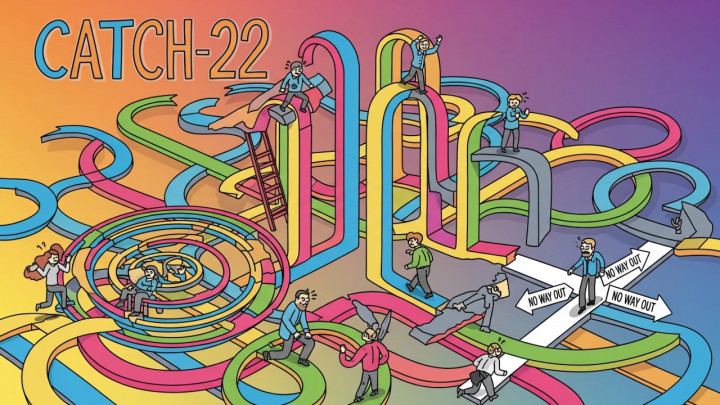The AI Winter Phenomenon: Overhyped Promises and the Cycles of AI Development
The history of artificial intelligence (AI) is not a story of uninterrupted triumph. Time and again, periods of immense expectation and initial enthusiasm have been followed by disillusionment and stalled progress. These periods are known as "AI Winters," times when faith in AI research and development wavers, funding dries up, and the field appears to stagnate. Understanding AI Winters is crucial for gaining a realistic perspective on AI's past, present, and potential future.

What is an "AI Winter" and Why Does it Matter?
The term "AI Winter" emerged in the mid-1980s to describe periods when interest in artificial intelligence research and associated funding drastically declined. These winters represent more than just a slowdown in development; they signify a crisis of confidence in the field's capabilities and promises. They are typically triggered by the gap between excessive optimism ("hype") and actual results, occurring when the technology fails to deliver on often unrealistic expectations.
These cycles have globally influenced research directions, investment strategies, and even public perception of AI. Understanding them helps avoid repeating past mistakes and fosters more realistic expectations for the technology.
The First AI Winter (approx. 1974–1980): The Limits of Ambition
In the 1950s and 60s, the dawn of AI, enthusiasm was enormous. Thinking machines seemed just around the corner. However, by the 1970s, the limitations became apparent:
- The Combinatorial Explosion: Algorithms of the time could handle simpler problems, but they failed when faced with real-world complexity, where the number of possible solutions grows exponentially.
- Limited Computational Power and Data: Hardware was simply not powerful enough for the ambitious goals, and the vast datasets that fuel today's AI models were unavailable.
- Critical Reports and Funding Cuts:
- ALPAC Report (1966, USA): Although earlier, this report foreshadowed the disillusionment. It delivered a scathing assessment of the state of machine translation, significantly cutting funding in the area and contributing to a skeptical atmosphere.
- Critique of Perceptrons (Minsky & Papert, 1969, USA): This book mathematically demonstrated the fundamental limitations of simple neural networks (perceptrons) of the time (e.g., their inability to solve the XOR problem), setting back connectionist (neural network) research for a long period.
- Lighthill Report (1973, UK): Sir James Lighthill critically evaluated UK AI research, highlighting AI's failure to meet its grandiose promises even in basic areas like robotics and language processing. As a result, the British government drastically cut funding for AI research.
- DARPA's Disillusionment (USA): The US Defense Advanced Research Projects Agency (DARPA), a major funder of AI research, grew increasingly dissatisfied with results in the early 70s, particularly with the slow progress of the Speech Understanding Research (SUR) program. This led to significant restructuring and reduction in funding.
These factors combined led to the first AI Winter, during which research activity slowed, funding dried up, and many turned away from the field.
You can read more about the first AI winter here.
The Second AI Winter (approx. 1987–mid-1990s): The Fall of Expert Systems
In the early 1980s, AI regained momentum, primarily due to the success of "expert systems." These were programs designed to model the knowledge and decision-making logic of human experts in narrow domains. An industry flourished, and specialized hardware (LISP machines) was developed to run them.
However, a second winter arrived, mainly due to:
- Limitations of Expert Systems: It became clear that these systems were brittle, difficult to maintain, and updating their knowledge was extremely labor-intensive (the "knowledge acquisition bottleneck"). They couldn't learn or generalize their knowledge to new situations and lacked common sense.
- Collapse of the LISP Machine Market (1987): Demand for the expensive, specialized LISP machines developed for expert systems collapsed as the performance of general-purpose workstations (e.g., from Sun, or even PCs) caught up, and LISP software environments became available on them. The specialized hardware became economically unviable.
- Renewed Overpromising: The hype surrounding expert systems again created unrealistic expectations that the technology couldn't meet, leading to renewed disillusionment.
The second winter was perhaps less "frigid" than the first, but it still brought significant funding cuts and waning interest.
Consequences of AI Winters and the Revival
AI Winters didn't solely have negative consequences. Although funding shrank and many projects were halted, the downturns also provided important lessons:
- More Realistic Goals: Researchers were forced to set more pragmatic, measurable objectives.
- Search for New Approaches: Failures spurred the exploration of alternative methods, such as statistical machine learning and the rediscovery of previously sidelined neural networks.
- Importance of Basic Research: It became evident that long-term basic research was necessary, rather than focusing solely on short-term, application-oriented projects.
From the late 1990s and 2000s onwards, a new "spring" gradually dawned for AI. The drivers were:
- Explosion in Computing Power (Moore's Law, GPUs): Increasingly powerful and cheaper hardware enabled the execution of previously intractable, computationally intensive algorithms.
- The Internet and "Big Data": Massive amounts of digital data became available, essential for training modern machine learning models (especially deep learning).
- Algorithmic Breakthroughs: More advanced machine learning techniques, followed by the deep learning revolution from the 2010s, brought significant progress in areas like image recognition, speech recognition, and natural language processing.
Large corporations (Google, Facebook, Microsoft, Amazon, etc.) invested heavily in AI R&D, accelerating innovation and the integration of AI into everyday technologies.
The Current AI Boom and the Possibility of Another Winter?
Currently (as of April 2025), we are in the midst of an unprecedented AI boom, fueled primarily by the spectacular successes of generative AI (e.g., ChatGPT, DALL-E, Midjourney). Investment is breaking records, and interest is immense. The question arises: is this growth sustainable, or is another AI Winter approaching?
Arguments for a new winter:
- Unrealistic Expectations (AGI Hype): Exaggerated promises have resurfaced, especially regarding the imminent arrival of Artificial General Intelligence (AGI), while current systems still have significant limitations (e.g., lack of true understanding, "hallucinations," energy demands).
- Questions of Economic Return: While the technology is impressive, the business models for many generative AI applications are not yet mature, and their development and operation are extremely costly. If the expected economic benefits fail to materialize, investor enthusiasm could wane.
- Scaling Limits and Costs: Training and running current large models require enormous computational power and energy. It's questionable how long this is sustainable or can be increased economically.
- Ethical and Regulatory Challenges: The spread of misinformation, workforce transformation, data privacy concerns, and potential misuse raise serious societal and regulatory questions that could slow or limit AI adoption.
- Hitting a Technological Plateau: It's possible that current architectures (e.g., transformers) are reaching the limits of their capabilities, and without further fundamental breakthroughs, progress could slow down.
Arguments against a new winter:
- Real Value Creation: Unlike previous winters, today's AI is already creating tangible value in numerous fields (e.g., medical diagnostics, logistics, scientific research, software development, creative industries).
- Widespread Adoption: AI is no longer confined to research labs; it's embedded in our daily lives and business processes.
- Diversified Funding: While venture capital is important, large corporations and governments are also significant long-term investors.
- Continuous Algorithmic Progress: Research is extremely active, with new ideas and refinements constantly emerging.
Conclusion: While another deep "AI Winter" similar to the past might be less likely due to the technology's current embeddedness and practical utility, some form of "cooling off," a slowdown in the growth rate, or a correction of the hype cycle is not out of the question. The future depends on whether the field can navigate the technological, economic, and ethical challenges and continue to deliver real, sustainable value instead of just inflated promises.





